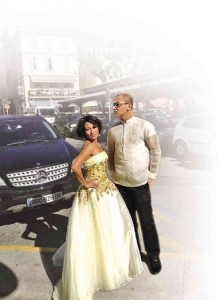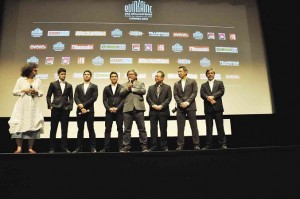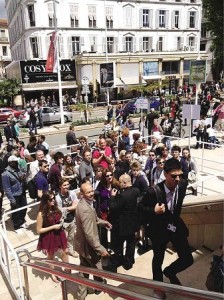Postscript to Cannes

DRENCHED but dressed to the nines, cineastes queue up for “Like Father, Like Son” gala. Photo by Bayani San Diego Jr.
Speaking like the grizzled veteran of countless skirmishes on Boulevard de la Croisette that he was, Filipino filmmaker Tikoy Aguiluz told a skeptical neophyte: “The pink press ID is the best badge in Cannes.”
Evelyn Vargas, another seasoned warrior-actress and, this year, supervising producer (for Adolfo Alix Jr.’s “Death March,” an entry in the Un Certain Regard section), put it succinctly: “Press people enjoy certain rights here in France.”
An executive for another top-tier festival was overheard telling friends: “I’d rather have a press badge than my programmer’s ID.”
Indeed, the pink ID guaranteed considerable access and, unlike mere mortals, the holder didn’t have to fall in line for press screenings. Wave the badge and doors miraculously opened.

“NORTE” actors Angeli Bayani and Archie Alemania stop traffic near the Croisette. Photo by Bayani San Diego Jr.
Merely looking at the tiny, nondescript pink ID (“rose” in French) wouldn’t explain the fuss.
Article continues after this advertisementIt would take any neophyte an entire month to process the 12-day Cannes adventure although, at the end of the four weeks, he would still be flummoxed by the strange powers of that plastic badge.
Article continues after this advertisement
Lessons learned
It always pays to heed lessons from the past, so here are a few tips for future Cannes soldiers to keep in mind before plunging into the trenches.
1) Accreditation ends a month and a half before the festival, which usually begins second week of May. Accomplish all necessary forms online well before the deadline—Unless, of course, you personally know one of the gods of the Palais or one of the competitors in the fest.
2) Make sure to submit a decent photo for the ID. You’ll be wearing that ID for two weeks. No passport photos, please. Filmmaker Lav Diaz (whose film “Norte, Hangganan ng Kasaysayan” also competed in the Un Certain Regard section) didn’t bother e-mailing a photo. Fest organizers had to scramble online for Diaz’s picture (they found one with Mayon volcano in the background). Actor Zanjoe Marudo (of “Death March”) sent a Zoolander-like glamour portrait, but he didn’t make it to the fest.

UNUSED badges issued to Filipino stars who didn’t make it to the festival this year. Photo by Bayani San Diego Jr.
3) Bring a bow tie. Evening screenings for the Main Competition films are strictly formal affairs—which means cocktail dresses or gowns for the ladies and suits for men.
During the rain-soaked premiere of Kore-eda Hirokazu’s “Like Father, Like Son,” a Caucasian guest was denied entry. He argued with the burly bouncer: “But I’m wearing a tie!” Beefy bodyguard pointed out: “Not necktie; bow tie.” A bow tie costs only P250 in SM.
Not even the formal barong Tagalog is acceptable on the red carpet. Briccio Santos, chair of the Film Development Council of the Philippines, wanted to wear a barong for the premiere of the digitally restored version of Lino Brocka’s “Maynila sa mga Kuko ng Liwanag.” Organizers told him to wear a tux instead. Luckily, he found a bow tie in a nearby Zara store. Cost: 16 euros (US$21).
Cannes is a big bonanza for the local fashion industry—time to make hay for bow-tie sellers and tux makers. But dressing up at the movies is also a matter of pride for the French. It seems that traipsing on the red carpet in your Sunday best is a feeling akin to worshipping in the grand cathedral of cinema. There’s a Catholic church (Our Lady of Good Voyage) near the Palais, by the way.
4) Bring an umbrella. Two words: Climate change. In the past, Cannes was pictured as a beach holiday but these days, even the weather can be bipolar—drizzling one day, sizzling the next. You don’t want to patronize those dubious peddlers preying on drenched tourists. According to a Filipino who resides in Cannes, it snowed last winter. Bianca Zialcita, a Filipino actress based in Switzerland, tried to take a morning dip in the sea, “but the water was freezing.” Also bring shawls, scarves and jackets because it gets chilly at night.
5) Press people are provided their own mailboxes, in which important correspondences (along with heaps of press kits and some lavish book-bound souvenir programs) are stashed.
To find your mailbox, look for your number (labeled Casier on your ID) among the shelves on the third level of the Palais
—same floor as the press office and press conference rooms.
6) Ah, the press cons. Pink IDs are welcome to all press cons. Make sure to be there an hour before the schedule, so you can get seats in the front row— the better to take snapshots of Hollywood stars like Robert Redford, Matt Damon and Michael Douglas up close. If you’re going to ask a question, do stand up. Some stars can be hard of hearing.
As Redford admitted: “My hearing was ruined during the shooting of our film (JC Chandor’s “All is Lost”).” He said he was required to dive in open seas.
7) Read the handbook provided in the Cannes participants’ bag. A lot of useful information is in there—including a directory of pertinent numbers and a map of the Croisette and Riviera.
8) Never be late. No such thing as Filipino time in Cannes. Best to come in 30 minutes before the start of each screening. If you want to get a good seat, make that 45 minutes.
9) It’s smart to watch the Main Competition films during the first screening of the day, at 8:30 a.m. Don’t worry: Jet lag would make waking up early a cinch. Tickets/invitations to competing films are hard to come by and online reservations can get fierce. Press screenings are the most convenient means to get in the Palais and, as incentive, you don’t have to dress up for the morning shows. No jackets and bow ties.

“ON THE JOB” Q&A with (from left) actors Rayver Cruz, Piolo Pascual, Gerald Anderson, director Erik Matti, producers Dondon Monteverde and Leo Po, and actor Joel Torre Millett Soto
10) If you want to veer away from the press screenings schedule, you’re free to do so, but at your own risk. Some screenings can get jam-packed quickly (like the screening of the Andy Lau film, Johnnie To’s “Blind Detective”). Or you can try your luck and be pleasantly surprised by the presence of the likes of Bernardo Bertolucci (who turned up at the screening of the digitally restored “The Last Emperor” in 3D at the recent fest).
11) So you won’t go hungry, pack a lot of instant noodles and canned goods in your check-in baggage. Pizzas and pasta meals cost anywhere between 14 to 20 euros (US$19 to US$27). If you suddenly crave rice, there’s a Filipino store near Boulevard d’Alsace, across the train station. Delegates can have free coffee/water (and beer after 5 p.m.) in the lounge on the second floor and in the basement of the Marche du Film (near the Philippine booth in the Market) at the Palais.
12) Best to know some handy French phrases. But don’t try to impress your hosts by greeting them in their native tongue—unless you are prepared to take in a barrage of French. An important line to know: “Bon jour! Je ne parle pas Francais. (Good morning! I don’t speak French.)”
13) If you lose something, proceed to the Lost Properties office, which is near the casino at the right side of the Palais main entrance. (It’s in the map in the handbook.) Such cases are usually handled by the National Police, not the Municipal Police.
14) Press people are invited to a traditional “Provençal” luncheon with the mayor and the jury (this year included chair Steven Spielberg and members Nicole Kidman and Christoph Waltz) two days before the end of the fest. It’s wise to confirm early (preferably on the day you receive the invite), because slots run out swiftly.
If you manage to get a seat, just wear comfortable shoes and brace yourself for the steep climb up a hill to the venue, the Place de la Castre, Le Suquet, in “the old part of town,” a 15-minute leisurely walk from the Palais. When you’ve had enough of star-gazing, the castle grounds offer a breathtaking view of the Mediterranean.
15) Make sure to check the listings for Q&As with the cast and crew. Screenings for the recent fest’s Directors’ Fortnight were at Theater Croisette of the JW Marriott Hotel—a brisk, 10-minute walk from the Palais. Q&A for the “On the Job” team was in the morning screening and was attended by filmmaker Erik Matti and actors Joel Torre, Piolo Pascual, Rayver Cruz and Gerald Anderson.
16) Hotel rates are from 400 to 500 euros (US$535 to US$669) a night during peak season. It makes perfect sense to get yourself adopted by Filipino families. A big thanks to Loremi Cedo-Villones’ family and friends.
Cannes is what you make of it. As Diaz, another first-timer, pointed out: “Akin to the ancient agora, it’s hot, noisy, chaotic. But Cannes is a great forum for cinema.”
It’s like Mecca, a holy pilgrimage for cineastes. And if you manage to survive its madness, you can claim to be a hajji among film buffs after.
As bonus, the pink ID bestows on you an intoxicating sense of power for 12 days.
It makes a nifty souvenir, too—if you can’t afford the Cannes ref magnet that costs 10 euros (US$13).

